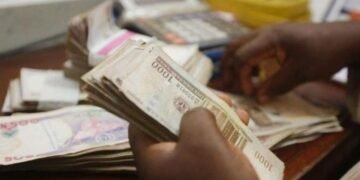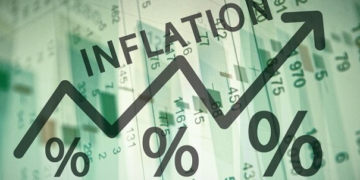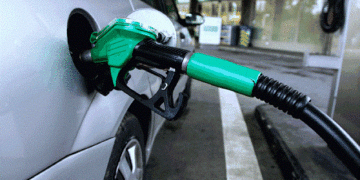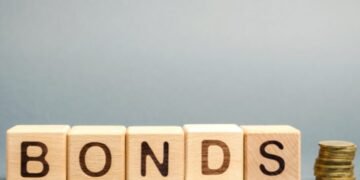Nigeria has officially entered a recession as the nation’s Gross Domestic Product (GDP) contracted by -3.62% (year-on-year) in real terms for the third quarter (July to September 2020). Thus marking the second consecutive quarterly GDP decline. This is according to the GDP report released by the National Bureau of Statistics (NBS).
Economists consider a recession as two consecutive contractions of the GDP. This is the second recession in five years. Although the current recession is worse than that of 2016.
The growth in Q3 2020 was slower by 5.90% points when compared to the third quarter of 2019 which recorded a real growth rate of 2.28% year on year. Nevertheless, it represents an improvement of 2.48% compared to the second quarter 2020, due to the improved economic activities resulting from the lifting of movement restrictions across the country.
The 3-year trend of low but positive real growth rates recorded since the 2016/17 recession, was ended in the second quarter of 2020 when the GDP plunged by 6.10%.
Have you read?
- Naira tumbles further against major currencies at the parallel market
- Inflation rate in Nigeria rises to 14.23% in October 2020, highest since March 2018
According to the NBS report, 18 economic activities recorded positive growth in Q3 2020, compared to 13 activities in Q2 2020. Despite the improvement, this figure remains low compared to 30 recorded in the first quarter of the year.

Source: NBS
In nominal terms, aggregate GDP stood at N39.89 trillion in the quarter in review. This is 2.8% higher than the third quarter of 2019 (N37.807 trillion) according to the report.
Contributions to Real GDP in a broad category
- Oil Sector – 8.73% (Q2 2020 – 91.07%)
- Non-oil sector – 91.27% (Q2 2020 – 8.93%)
Further breakdown of contributions to Real GDP
- Agriculture – 30.77% (Q2 2020 – 24.65%)
- Industries – 21.59% (Q2 2020 – 21.87%)
- Services – 47.64% (Q2 2020 – 53.49%)
More detailed analysis
The Oil sector contributed 8.73% to total real GDP in Q3 2020, down from figures recorded in the corresponding period of 2019 and the preceding quarter, where it contributed 9.77% and 8.93% respectively.
The real growth of the oil sector was -13.89% (year-on-year) in Q3 2020.
The average daily oil production recorded in the third quarter of 2020 stood at 1.67 million barrels per day (mbpd), or 0.37mbpd lower than the average production recorded in the same quarter of 2019 and 0.14mbpd lower than the production volume recorded in the second quarter of 2020
In real terms, the Non-Oil sector accounted for 91.27% of the nation’s GDP in the third quarter of 2020, higher than its share in the third quarter of 2019 (90.23%) and the second quarter of 2020 (91.07%).
The non-oil sector contracted by –2.51% in real terms during the reference quarter, which is –4.36% points lower than the rate recorded in Q3 2019 but 3.54% points higher than in the second quarter of 2020. The first decline in real non-oil GDP growth rate since Q3 2017 was recorded in the second quarter of the year.
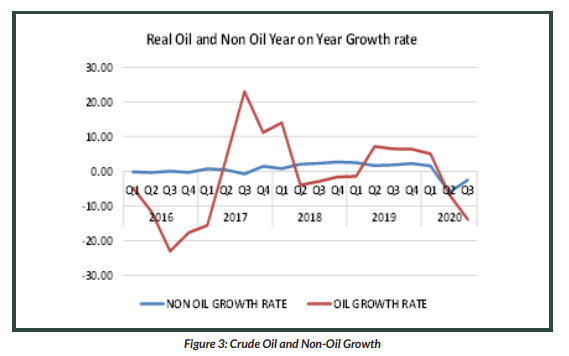
Source – NBS
Agriculture contributed 30.77% to overall GDP in real terms in Q3 2020, higher than the contribution in the third quarter of 2019 and the second quarter of 2020 which stood at 29.25% and 24.65% respectively.
Four sub-activities make up the Agricultural sector: Crop Production, Livestock, Forestry, and Fishing. Crop Production remained the major growth driver of the sector, as it accounted for 92.93%87.34% of nominal GDP in the sector in Q3 2020.
In the third quarter of 2020, the agricultural sector grew by 1.39% (year-on-year) in real terms, a drop of 0.89% points from the corresponding period of 2019, and a decrease of –0.19% points from the preceding quarter
- Read also; Nine months 2020: UBA reports N77.132 billion profit, lags behind the GAZ in FUGAZ
- Zenith Bank Plc rakes in N509bn gross earnings, Profit after tax rises by 5.7%
- Nine months 2020: Access Bank’s N102.30bn profit beats N97.50bn 2019 FY profit
The contribution of Mining and Quarrying to Real GDP in the quarter under review stood at 8.91%, lower than the rate of 9.90% recorded in the corresponding quarter of 2019 and the 9.08% recorded in the second quarter of 2020 respectively.
The Mining & Quarrying sector consists of Crude Petroleum and Natural Gas, Coal Mining, Metal ore and Quarrying, and other Mineral sub-activities. Crude Petroleum and Natural gas was the main contributor to the sector with a weight of 97.53% in Q2 2020
Manufacturing contributed 8.93%, higher than the 8.74% recorded in the third quarter of 2019 and higher than the 8.82 recorded in the second quarter of 2020.
Real GDP growth in the manufacturing sector, in the third quarter of 2020, was –1.51% (year on year), lower than the same quarter of 2019 but higher than the preceding quarter by –2.60% points and 7.27% points respectively
The Manufacturing sector is comprised of thirteen activities: Oil Refining; Cement; Food, Beverages and Tobacco; Textile, Apparel, and Footwear; Wood and Wood Products; Pulp Paper and Paper products; Chemical and Pharmaceutical products; Non-metallic Products, Plastic and Rubber products; Electrical and Electronic, Basic Metal and Iron and Steel; Motor Vehicles and Assembly; and Other Manufacturing.
Construction contribution to total real GDP was 3.21% in the third quarter of 2020, which is higher than its contribution of 3.01% in the same quarter of the previous year, and lower than in the immediate past quarter where it contributed 3.23%.
The real growth rate of the construction sector in the third quarter of 2020 was recorded at 2.84% (year on year), higher by 0.47% points from the rate recorded a year earlier.
Trade contributed 13.88% to GDP in real terms in Q3 2020, lower than the 15.23% it represented in the previous year, and the 14.28% recorded in 2020. This is a further decline from 16.08% recorded in Q1 2020.
Finance and Insurance contribution to real GDP totaled 2.67%, higher than the contribution of 2.49% recorded in the third quarter of 2019, but 1.33% points lower than 4.00% recorded in Q2 2020.
Growth in this sector was estimated at 3.21% during Q3 2020, or 2.14% points from the rate recorded in the third quarter, though down by –15.29% points from the rate recorded in the preceding quarter. Quarter on quarter growth in real terms stood at –25.24%
The Finance and Insurance Sector consists of the two subsectors, Financial Institutions and Insurance,
which accounted for 88.89% and 11.11% of the sector in real terms in Q3 2020.
Gross Domestic Product (GDP) is the total monetary or market value of all the finished goods and services produced within a country’s borders in a specific period. As a broad measure of overall domestic production, it functions as a comprehensive scorecard of the country’s economic health.
Real GDP takes into account the impact of inflation and allows comparisons of economic output from one year to the next and other comparisons over periods of time.
By: Ifunanya Ikueze









